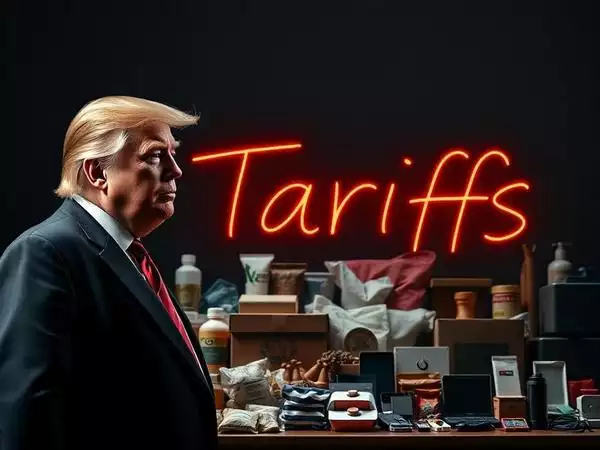The financial markets are no stranger to volatility, but recent headlines surrounding former President Donald Trump’s proposed tariffs and escalating geopolitical tensions have sent shockwaves through global equities. As investors grapple with uncertainty, analysts at blockchain analytics firm Nansen are urging caution, echoing the age-old trading adage: “Don’t fight the tape.”
In trading parlance, “the tape” refers to the market’s price action—its trends and momentum. Fighting the tape means going against the prevailing market direction, a strategy that often leads to losses when sentiment is overwhelmingly bearish or bullish. With Trump’s renewed push for aggressive trade policies and fears of a broader economic slowdown, Nansen’s warning comes at a critical juncture for traders and long-term investors alike.
The Return of Trump’s Tariffs: A Market Wildcard
Donald Trump, the presumptive Republican nominee for the 2024 U.S. presidential election, has reignited fears of a trade war by proposing a universal 10% tariff on all imports and a staggering 60% levy on Chinese goods. These measures, if implemented, could disrupt global supply chains, increase consumer prices, and trigger retaliatory actions from trading partners.
Historically, markets have reacted negatively to trade wars. During Trump’s first term, the S&P 500 saw sharp sell-offs each time tariffs were escalated, particularly during the U.S.-China trade war of 2018-2019. Now, with inflation still above the Federal Reserve’s target and interest rates at multi-decade highs, another round of tariffs could exacerbate economic pressures.
Market Reactions So Far
- Equities: U.S. stocks have shown increased volatility, with sectors heavily reliant on imports—such as technology and consumer goods—facing downward pressure.
- Cryptocurrencies: Bitcoin and other digital assets, often seen as hedges against macroeconomic instability, have seen mixed reactions, reflecting broader risk aversion.
- Commodities: Industrial metals and agricultural products could face supply constraints, while gold—a traditional safe haven—has seen renewed interest.
Nansen’s data indicates that institutional investors are rotating into defensive assets, suggesting a risk-off sentiment.
Why ‘Don’t Fight the Tape’ Matters Now
Market trends are shaped by collective psychology, and right now, fear is dominating. Nansen’s analysts emphasize that traders should avoid contrarian bets unless they have strong conviction and risk management in place.
Key Reasons to Exercise Caution:
- Momentum is Bearish (For Now)
- Technical indicators across major indices show weakening momentum.
- The CBOE Volatility Index (VIX), often called the “fear gauge,” has spiked.
- Policy Uncertainty is High
- Trump’s tariff plans are still speculative, but markets are pricing in potential disruptions.
- The Fed’s rate path remains unclear—will they cut rates if growth slows, or hold firm on inflation?
- Geopolitical Risks Are Escalating
- Beyond trade wars, conflicts in the Middle East and Ukraine continue to threaten oil supplies and global stability.
What Should Investors Do?
Nansen’s advice aligns with classic risk management principles:
- Respect the Trend: If the market is selling off, don’t assume a quick rebound. Wait for confirmation of a reversal.
- Diversify Defensively: Shift some exposure to cash, bonds, or gold if volatility persists.
- Watch for Institutional Moves: Large players often signal market turns—track hedge fund activity and ETF flows.
Historical Precedents: Trade Wars & Market Impact
Looking back at 2018-2019, the U.S.-China trade war led to:
- S&P 500 Correction: A near-20% drop in late 2018.
- Supply Chain Shocks: Companies like Apple and NVIDIA saw earnings downgrades due to tariff costs.
- Fed Intervention: The central bank paused rate hikes and eventually cut rates to stabilize markets.
If Trump’s proposed tariffs take effect, history suggests markets could face a similar—or worse—reaction.
The Crypto Angle: Safe Haven or Risk Asset?
Cryptocurrencies have been a wildcard in recent years. Bitcoin surged during the COVID-19 stimulus era but struggled in high-rate environments. Now, with trade war fears rising, crypto’s role is unclear:
- Bull Case: Bitcoin as “digital gold” could attract避险 (safe-haven) flows.
- Bear Case: If risk assets sell off broadly, crypto may follow stocks downward.
Nansen’s on-chain data shows mixed signals—while some large holders are accumulating, retail interest remains subdued.
Conclusion: Patience Over Predictions
In times of uncertainty, the best strategy is often the simplest: Don’t fight the tape. Until the market establishes a clearer direction, traders should avoid aggressive positions and focus on capital preservation.
For long-term investors, dips may present buying opportunities—but only if fundamentals remain strong. As Nansen’s analysts warn, “The market can stay irrational longer than you can stay solvent.”
